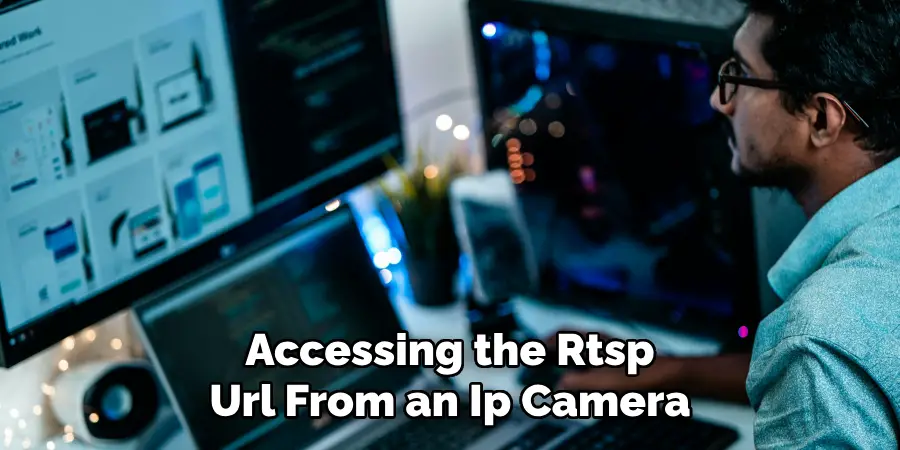When working with IP cameras, accessing the Real-Time Streaming Protocol (RTSP) URL is a crucial step for integrating video feeds into various applications or systems. The RTSP URL enables users to access the live stream of the camera using compatible media players or software. This process involves identifying specific network settings and credentials associated with the IP camera.

Whether for security monitoring, content creation, or remote viewing, understanding how to obtain the RTSP URL unlocks a myriad of possibilities for effectively utilizing IP camera technology. In the following sections, we will guide you through how to get RTSP URL from IP camera, ensuring a seamless streaming experience.
Purpose of Accessing the RTSP URL
Accessing the RTSP URL from an IP camera serves multiple purposes, making it a valuable asset in various applications. Firstly, it enables secure and efficient real-time video streaming for surveillance and monitoring systems. This capability is essential for ensuring safety in public spaces, businesses, and residential areas. Secondly, the RTSP URL facilitates the integration of video streams into custom applications, providing developers with the flexibility to enhance user interfaces or gather data for analytics.

Additionally, content creators and broadcasters utilize these URLs to seamlessly stream live events or connect with audiences across different platforms. Understanding and leveraging the RTSP URL thus opens up a wide range of possibilities, ensuring that video data is both accessible and optimally used in various contexts.
Understanding the RTSP Protocol and URL Structure
The Real-Time Streaming Protocol (RTSP) is a network control protocol designed to establish and control media streaming sessions between client devices and servers. It plays a crucial role in managing the delivery of real-time data, such as audio and video, over IP networks. RTSP is similar to the Hypertext Transfer Protocol (HTTP) but is specifically tailored for streaming media, allowing users to pause, play, or record live transmissions with ease.
An RTSP URL is a distinct address that specifies the location where the media stream can be accessed. The typical structure of an RTSP URL follows the format: `rtsp://username:password@ip_address:port/stream_path`. In this structure:
- `rtsp://` denotes the protocol being used.
- `username:password` provides the necessary credentials for accessing the camera stream. These fields are optional, depending on the security settings of the IP camera.
- `ip_address` refers to the IP address of the camera on the network.
- `port` specifies the communication port used by the RTSP service. If the camera operates on the default RTSP port, this field may be omitted.
- `stream_path` is a unique identifier that directs the request to the appropriate stream on the camera.

Understanding this URL structure is crucial when setting up the stream for various applications, ensuring that the correct data is accessed with the appropriate security measures in place. By mastering the RTSP protocol and interpreting its URLs, users can efficiently manage and deploy IP camera streams across multiple platforms.
10 Methods How to Get RTSP URL from IP Camera
1. Check the Manufacturer’s Documentation
First things first—always check the documentation provided by the camera manufacturer. Many brands include the RTSP URL format in their user manuals or online resources. This is often the most straightforward method, as manufacturers like Axis, Hikvision, and Dahua are known to provide clear instructions.
2. Use the Camera’s Web Interface
Most IP cameras come with a web interface accessible through a browser. Log in using the camera’s IP address and search for streaming settings. You can often find the RTSP URL within the network or video settings. This method is quick and relies solely on having administrative access to the camera.
3. Leverage ONVIF Device Manager
ONVIF (Open Network Video Interface Forum) is a standard for network cameras. Download the ONVIF Device Manager, a tool that searches for IP cameras on the local network. The software displays various parameters, including the RTSP URL, making it a reliable tool for devices supporting ONVIF.
4. Try Default URL Formats
Many cameras use common URL formats for RTSP streams. You can try generic formats such as `rtsp://username:password@ipaddress/streaming/channels/101`. Adjust parameters like the port number and channel based on your setup. This trial-and-error method requires patience but can be effective.

5. Consult Online Forums and Communities
Tech communities and forums like Reddit, IPCamTalk, and Stack Overflow are treasure troves of shared knowledge. Security professionals and enthusiasts often discuss and solve issues related to IP cameras, including sharing RTSP URL formats for various models. An active engagement in these forums can yield useful information.
6. Use Packet Capturing Software
For the tech-savvy, packet capturing software like Wireshark can be invaluable. By monitoring the network traffic between the camera and a viewing application, you can trace the RTSP URL. This method requires a good understanding of network protocols but offers deeper insights into your security setup.
7. Explore Vendor-Specific Tools
Manufacturers often provide dedicated software tools for camera configuration. Tools from brands such as Hikvision’s SADP or Dahua’s ConfigTool might display RTSP URLs among other camera settings. Ensure you have the latest version of these tools for optimal functionality.
8. Connect with the Camera’s Support Team
Don’t underestimate the power of customer support. Reaching out to the manufacturer’s technical support can provide direct answers and specific RTSP URL structures for your camera model. Keep your camera’s model number and firmware version handy for a speedy resolution.
9. Experiment with Third-Party Software
Applications such as VLC Media Player or iSpy offer built-in functionalities for probing RTSP streams. These programs can automatically detect the RTSP URL when you input the camera’s IP details, offering a user-friendly way to capture live streams.
10. Consider Firmware Updates
Keeping your camera’s firmware updated can resolve connectivity issues and sometimes add new features, including easier access to RTSP URLs. Always check the manufacturer’s website for the latest updates and follow provided instructions carefully.
With these methods, you can efficiently obtain RTSP URLs for your IP cameras, enhancing your ability to integrate and manage security systems. By mastering these approaches, you’ll position yourself as a knowledgeable resource in the field of surveillance technology.
Maintenance and Upkeep
Ensuring the optimal performance of your IP cameras involves regular maintenance and updates. Consistent upkeep helps in prolonging the lifespan of the devices and maintaining system reliability. Begin by ensuring that the cameras and their lenses are clean, as dust and debris can obstruct the view and affect image quality. Periodic cleaning using appropriate materials can make a significant difference. Additionally, check and tighten all physical connections, as loose cables can result in intermittent connectivity issues.
Another crucial aspect of maintenance is software management. Regularly update the firmware for both cameras and any related software applications. Firmware updates can introduce enhancements, resolve vulnerabilities, and sometimes offer new features that improve usability or security. It’s important also to periodically review and update user credentials for the cameras, ensuring that strong passwords are in use to prevent unauthorized access.
Lastly, perform routine checks on the storage systems, whether you are storing video on local servers or using cloud solutions. Ensure there is adequate space and that the storage systems are functioning correctly to prevent data loss. By following these maintenance practices, you can ensure that your IP camera system operates smoothly and securely over time.

Troubleshooting Common Issues
Handling common issues with IP cameras requires a systematic approach to identify and rectify the problem effectively. Start with checking connectivity if your camera cannot be accessed remotely. Ensure that both power and network cables are securely connected, as loose connections often lead to loss of signal. Additionally, confirm that the camera’s IP address is within the correct subnet and that there are no conflicts with other devices.
For issues with image quality, inspect the camera lens for dirt or obstructions. If the video feed is blurry or pixelated, adjust the focus and zoom settings within the camera’s interface. In cases where the camera is not capturing night vision properly, verify that the infrared LEDs are operational and not obstructed by any external covers.
If you encounter issues with streaming, verify the RTSP URL for accuracy. Incorrect format or typos can lead to streaming failures. Ensure that the ports required for RTSP are open and not blocked by firewall rules. For more advanced troubleshooting, log into the camera’s interface to check for error logs that might provide further insights into the problem.
Conclusion
Successfully managing and troubleshooting IP cameras requires a combination of strategic approaches and technical knowledge. Through attentive maintenance, regular updates, and effective troubleshooting techniques, you can ensure the reliability and functionality of your surveillance system. Obtaining RTSP URLs and leveraging supportive tools, forums, and vendor resources enhances your capability to handle security cameras efficiently. So, there you have it – a quick and easy guide on how to get rtsp url from ip camera.
